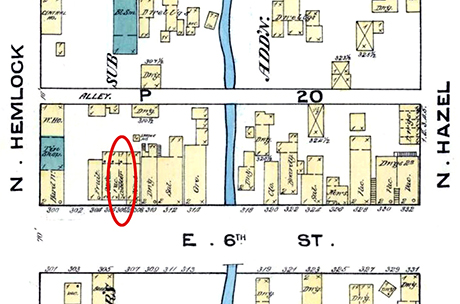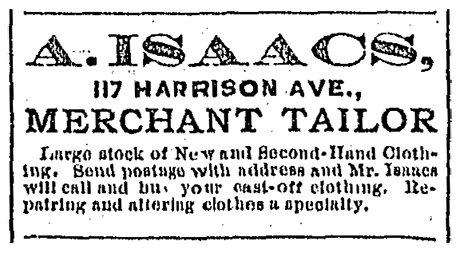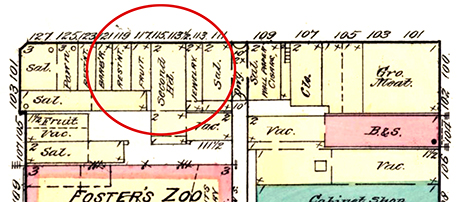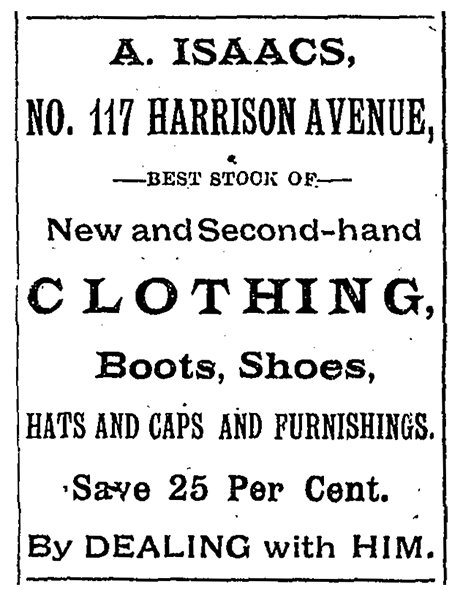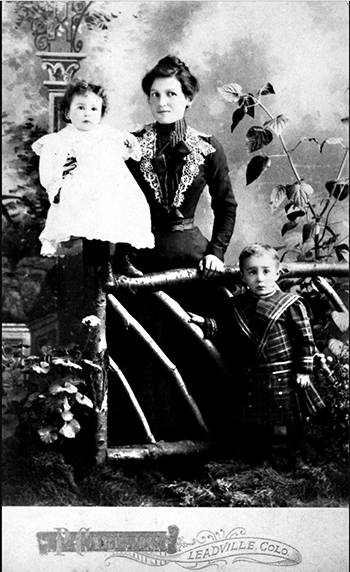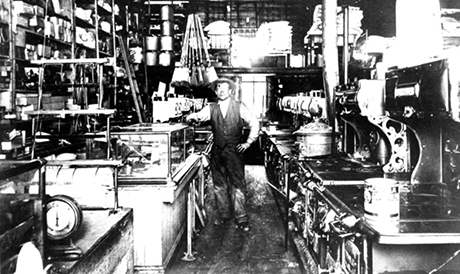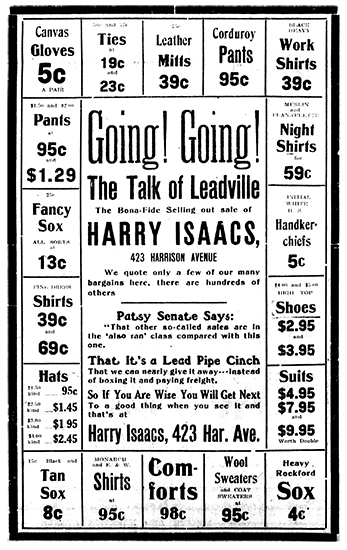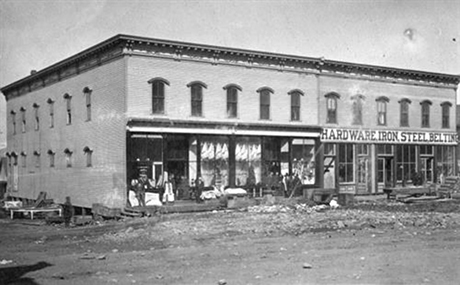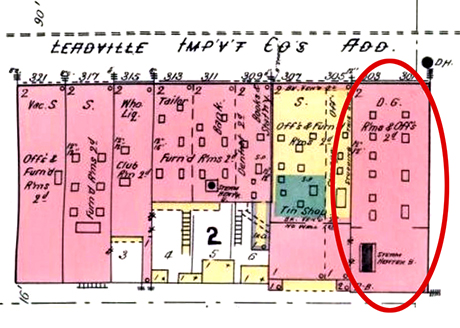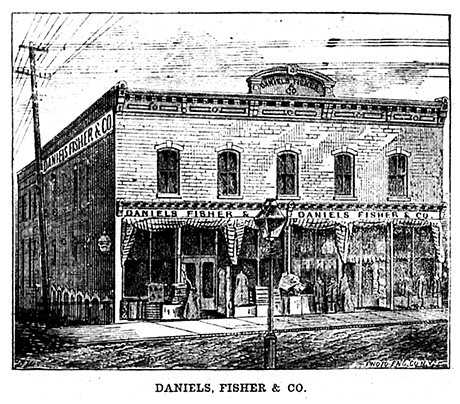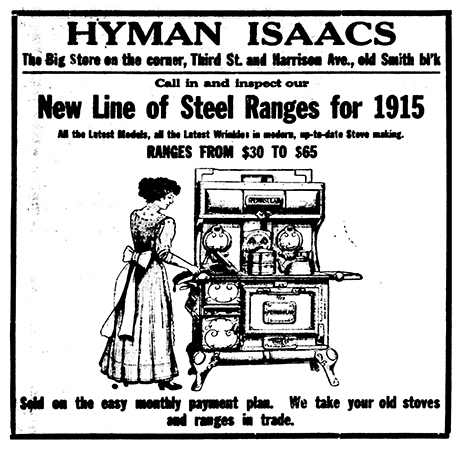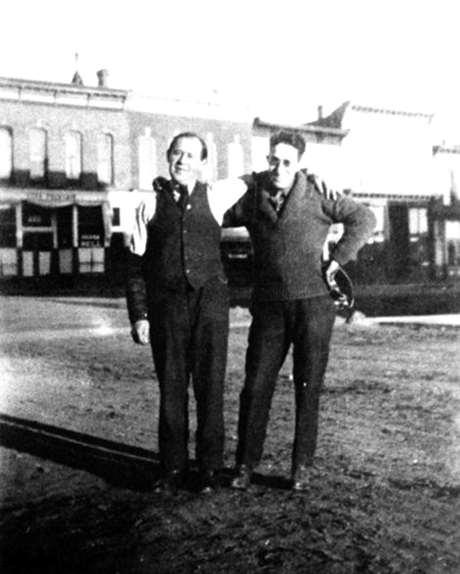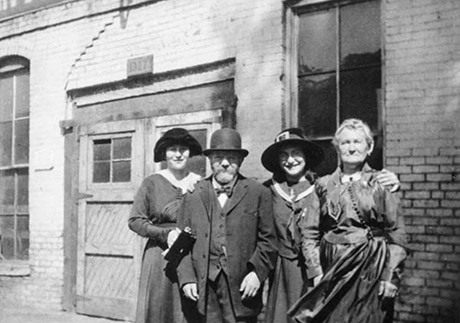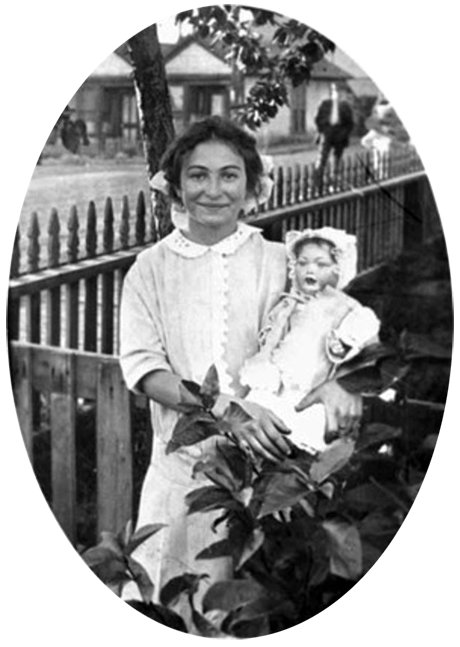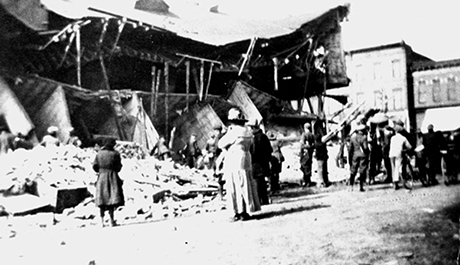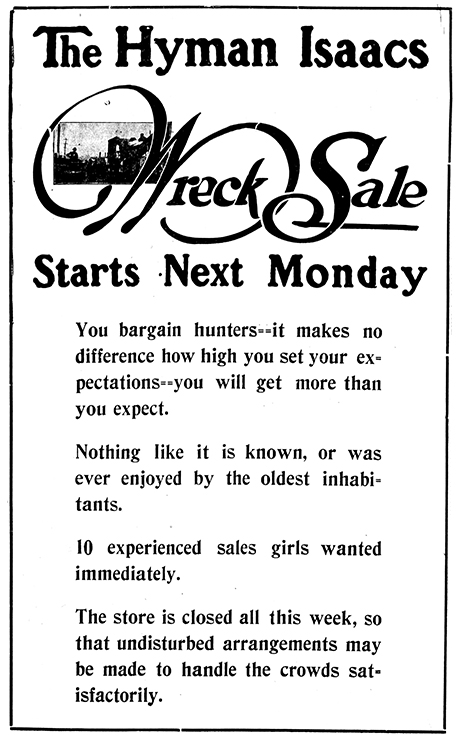Abraham Isaacs (In Leadville 1882-1900)
Born: 1852 (Warsaw, Poland)
Died: January 10, 1920 (Denver)
Married to: Faye (Fannie) Isaacs
Faye (Fannie) Isaacs (In Leadville 1882-1900)
Born: 1845 (Poland)
Died: March 2, 1911 (Denver)
Married to: Abraham Isaacs
Isaacs Infant
Born: Unknown
Died: July 15, 1897
Parents: Unknown
Lillian Isaacs
Born: 1905
Died: November 18, 1906 [1]
Parents: Unknown, perhaps Hyman and Celia or Harry and Anne
Hyman Isaacs (In Leadville 1882-1927)
Born: 1870 (England)
Died: April 19, 1939 (Denver)
Married to: Celia Isaacs (1897)
Parents: Abraham and Fannie Isaacs
Rebecca Mitgang (Isaacs) (In Leadville 1882-?)
Born: May 1879
Died: After 1940
Married to: Abraham Mitgang [2]
Parents: Abraham and Fannie Isaacs
Celia Isaacs (In Leadville 1890s-1927)
Born: 1875 (Austria)
Died: March 14, 1937 (Denver)
Married to: Hyman Isaacs (1897)
Harry Isaacs (In Leadville 1882- 1917)
Born: 1872 (England)
Died: 1940s (Chicago)
Married to: Anna Isaacs (1900)
Parents: Fannie and Abraham Isaacs
Anne Spiro (Isaacs) (In Leadville 1900-1917)
Born: 1882 (Illinois)
Died: 1962 (Chicago)
Married to: Harry Isaacs (1900)
Dora Hyman (Isaacs) (In Leadville 1882-1894)
Born: 1873
Died: September 4, 1894 (Leadville, Colorado)
Married to: Max Hyman (March 2, 1892 Leadville, Colorado)
Parents: Abraham and Fannie Isaacs
Meyer Isaacs (In Leadville 1886-1892)
Born: Around 1886 (Leadville, CO)
Died: December 20, 1892 (Leadville, CO)
Parents: Abraham and Fannie Isaacs
Sadie Isaacs (In Leadville 1900-1915)
Born: March 16, 1900
Died: November 1, 1918 (Chicago, IL)
Married to: None
Parents: Hyman and Celia Isaacs
Louis Isaacs (In Leadville 1898-1931)
Born: November 16, 1898
Died: April 1967
Married to: Charlotte Isaacs née Wolf (November 15, 1921)
Parents: Hyman and Celia Isaacs
Charlotte (Lottie) Isaacs (In Leadville 1903-Unknown)
Born: June 26, 1902 [3] (Leadville)
Died: November 12, 1984 (Denver)
Married to: Gold [4]
Parents: Hyman and Celia Isaacs
Charlotte Isaacs (Wolf) (In Leadville 1910s-1920s)
Born: May 6, 1894 [5] (Austria-Hungry)
Died: December 9, 1982 (California)
Married to: Louis Isaacs (1921)
Marian Clairs Isaacs (1926-Unknown)
Born: January 8, 1926 (Leadville, CO)
Died: August 13, 2002 (New York)
Married to: Unknown
Parents: Louis and Charlotte Isaacs
Edith Jane Isaacs (1924-Unknown)
Born: 1924 (Leadville, CO)
Died: Unknown
Married to: Unknown
Parents: Louis and Charlotte Isaacs
Helen Isaacs (1902- Unknown)
Born: 1902 (Leadville, CO)
Died: Unknown
Married to: Unknown
Parents: Harry and Annie Isaacs
Maurice Isaacs (1903- Unknown)
Born: 1903 (Leadville, CO)
Died: Unknown
Married to: Unknown
Parents: Harry and Annie Isaacs
Along with the Millers and Sanduskys, the Isaacs were one of the original and longest resident Jewish families in Leadville; they remained in the Carbonate City for nearly 50 years spanning three generations. Abraham Isaacs (1852-1920) was the patriarch of the family and along with his wife, Fannie (1845-1911), helped to build an important and eventful legacy in Leadville which folded insightfully into the fabric of the city’s larger history.
Abraham migrated to the United States in the early 1870s. His obituary in the Carbonate Chronicle of January 1920 gave him the title of “Pioneer Merchant” of Leadville and detailed a several year sojourn in London and New York after his departure from Warsaw, Poland. The Isaacs’ migration from Poland predates the large scale 1880s pogroms in Eastern Europe, so it was likely a result of anti-Jewish sentiment as well as poverty around Warsaw at the time. His sons, Hyman and Harry, and his daughters, Dora and Rebecca, were born in England in the early 1870s. Abraham’s obituary also noted a short stay in New York before the family’s arrival in Leadville. Details of time spent in London and New York are not available. For this study, their time in Leadville can be easily followed and the later success of the “Hyman Issacs” department store was the culmination of decades of tumult, trials, success and loss for the family.
Abraham and the family arrived in the new and bustling city of Leadville toward the end of 1882. This can be deduced from dates provided in his obituary and the fact that he does not appear in the directory of 1882; the publisher compiled the list of businesses and residents in the middle of the year and probably Abraham missed the count if he arrived later. He was accompanied by his wife Fannie, two young sons, Harry and Hyman, and two young daughters, Dora and Rebecca.
The year 1882 was one of Leadville’s most vibrant. In four short years, Leadville grew from a collection of hardscrabble cabins on a table land above the Arkansas River, into Colorado’s most important mining and industrial city.
At the end of 1882 and throughout 1883, Abraham’s first residence and business venue was located at 306 1/2 East 6th Street. This block boasted a number of small business such as a fruit stand, two saloons, a grocery, a cobbler, Abraham’s tailor shop, three boarding houses, two clothing stores, and a hardware store and tin shop. [6] Despite a three block separation from Harrison Avenue this was clearly an important commercial area. Newspapers are quiet on the happenings of the Isaacs family; a fact that would change quickly as they settled into the new city.
In 1884, the Isaacs relocated to 113 East 4th Street. [7] This was a second story accommodation above a newspaper printing office. [8] Abraham most likely did his tailor work in a parlor or common room in the upstairs residence. Fellow eastern European Jewish merchant Abraham Sandusky [9] would move into and manage the bathhouse across the street at 116 East 4th a few years later. The year 1884 was also a quiet one in newspapers for the family, but the following year would begin a much more vibrant and active life for the growing family.
In 1885, the Isaacs again relocated, this time to a residence at 114 West Chestnut Street. This was a high density area and the house into which the family moved was a small dwelling wedged between a laundry and a large boarding house. [10] Abraham moved his business from his residence to a storefront at 117 Harrison Avenue during this time. These moves proved to elevate Abraham into a more visible position in the clothing trade of “Lower Harrison Avenue”.
As a large and growing city, Leadville citizens were subject to crime both petty and more severe. Petty crime visited the Isaacs family many times during their time in Leadville, and many of these occurrences are documented in detail by local newspapers.
Abraham made his first appearance in a Leadville newspaper after he reported his overcoat stolen in January of 1885. [11] By March, police apprehended a man named William Johnson on the tip of a pawn shop owner who reported that Johnson had pawned the coat shortly after Abraham reported it missing. [12] Johnson was later found not guilty of the crime after evidence was presented in court that he had simply pawned the coat for the thief and had not directly stolen it. [13] This was an exemplary case of unscrupulous business dealings by fences and used clothing dealers in Leadville. The incident was also the first of many examples involving Abraham in the nearly untraceable illegal clothing trade in the city at the time. In the years that followed, Abraham would become involved with and be accused of similar schemes involving stolen goods. In fact, only three days before Johnson’s trial, police discovered clothing and snowshoes stolen from T. P. Michael’s cabin in Abraham’s store. The thief only went one block from Michael’s cabin on the 200 block of East 4th Street to Harrison avenue to sell the items to Abraham. [14] Two days later, a clerk at the Clarendon accused Abraham of stealing a $20 bill he had left in the pocket of a waistcoat sent in for tailoring. Police took Abraham to jail and he paid $300 bail. [15] The outcome of this case is unknown, but it was likely dropped.
In May, "Maurice Mangus” (likely Moritz Mankuss) [16] and Abraham were arrested for conducting a pawn store business without a license. This arrest ignited an ongoing feud with the city of Leadville and a number of merchants regarding the regulation of the second-hand trade. The dispute also vividly documented the nature and appearance of stores like Abraham’s:
“…When collector Flood was qualified and started out upon the performance of his labors he immediately sought to review every place that came under the license ordinance and among the smaller and more unpretentious place he found a number of second hand stores. The stock was of an exceedingly cheap character, and in many places could represent more than $200. This made no difference with the ordinance, however, and neglecting to pay the amount demanded by it, the collector proceeded to the enforcement of the penalty. The result was the arrest of Maurice Magnus and Isaacs two of the dealers who are conducting small establishments on the lower portion of the avenue… In the collectors office Mangus and Isaacs were overhauling the law and pointing out the hardships worked by it, when the reporter entered…”
In the ensuing debate both Mankuss and Isaacs pointed out various facts about their business, and several other dealers were accused by the pair of not paying for licenses. The matter remained undecided in May, but continued for a number of years after.
The 1885 Colorado State census compiled a count starting June 1. The “A.Isac and E. Isac” family were listed at 114 Chestnut street with sons “Heiman” 16 (Hyman), “Harris” 18 (Harry) and daughters Dora, 10 and Rebekah, 5 in the household. [17] An “Isicks" family with similar names is listed as residents of an illegible street name below “California Gulch” in the 1885 census. [18] Census takers often took liberties with families in order to boost their line counts, or perhaps misplaced families as the result of true error. It is not known who the latter family was, and the Chestnut street entry is the legitimate entry for the Isaacs family of this study.
In October, the law again visited the Isaacs household. According to the Carbonate Chronicle, a butcher named F. N. Bartold turned in a complaint against Abraham connected to the theft of his coat. The butcher had left with the coat with Abraham for repairs but did not hear about it for several weeks. When Bartlold returned he could not pay for the repairs and after negotiation agreed to come back when the full amount could be paid. A few weeks later Bartold returned and offered the full payment for the repair, but Abraham said he had sold the clothes. The Carbonate Chronicle reproduced the merchant’s accent as he explained himself in court,
“‘…you don’d call for your clothes in dime, unt you lose dem; I don’d do pishnes dot vay.’”
If this is an accurate example of his accent, is clear that Abraham’s use of English could have been a factor in the miscommunication of the scenario. It will never be known if this was an unscrupulous business deal or a miscommunication. The article also interestingly noted,
“…The testimony offered in defense would have made a stonewall wrinkle, and many times the audience, gathered to see the circus, broke out in roars of laughter. Even the stern and sturdy judge was observed to look at the statutes as though he were near sighted. After hearing the testimony, the case was held over until Wednesday at 2 o’clock.” [19]
The result of the case was that Mr. Isaacs did not have “felonious” intent and the matter was settled out of court between them. [20]
It was not long however before Abraham had another run in with local authorities. On Halloween 1885, the Carbonate Chronicle elaborated and added flourish to the description of Abraham’s establishment after his detainment for an unpaid license,
“The attention of police court was engaged by a solitary case this morning and Abraham Isaacs, the oldest patriarch in the fraternity of second-hand dealers, was raked over on a charge of conducting a pawn business without a license. With him in the court room was his venerable partner in life, Mrs. Isaacs who during her liege lord’s absence, furnishes ‘wall paper’ fit and makes it otherwise interesting for the customers.
A procession of these small houses, with raiment of every conceivable shape, from the discarded bum’s pants to the shining swallow tail, arranged before their doors with figures appended makes it the Chatham quarters of Leadville. Its transactions are anything but heaven, but to a certain class it is indispensable. The class of patronage is a peculiar one and embraces those characters who are more in search of economy than looks. The contributors to the stocks of clothing are generally found among the mining and prospecting classes whose clothes are, as a general thing, shed after each protracted trip through the hills, where they are exposed to the attacks and onslaughts of the ‘grey backs’.
They are then of no earthly use to the man whose nails have not obtained the length of the illustrious ‘Friday’ he who arranged the garments of Robinson Crusoe and made his toilet in the wilderness. ‘Crumby’ as the prospector calls it, there’s no means of effecting their exodus save to subject them to the flames, and the result is they are disposed of for anything the dealer consents to give, whether it be a song or a sixpence. These are the character of the goods that, as a general thing, stock the counters of this colony of Chatham streeters, and in many cases they are a God-send to the needy. Run through a hasty process of renovation, they are provided with a sort of second-hand gloss that commands from a dollar to five dollars, with a guarantee that Apollo never saw his form so gallantly nor handsomely displayed. It has saved not a few from ‘indecent exposure’ however and the shops are absolutely essential to the comfort of a certain species of mankind. Last spring the dealers, whose business at best won’t permit for anything but frugal diet, were hauled up by the collector, who demanded a pawn shop license in addition to that allowing them to vend their second-hand wares. There was terrible confusion for the time being, the dealers appealing to the clemency of the authorities and declaring that they could not live with the combined demands of revenue from them. The attack died prematurley and the matter was dropped from the records. Yesterday belligerence was renewed and Abraham Isaacs was brought up on the charge of violating the ordinance providing for pawn shops. It was on complaint of an informer who went to his establishment with a pair of gloves and soaked [sic sold] them for 25 cents. Having committed the old man he at once complained to the authorities, and he was called up to account. This morning the court took the matter under consideration and ruled that it was offering unreasonable temptations to violate the law and the defendant was discharged…”
After adjustment to life in the second-hand business, Abraham avoided mention in the newspapers until late spring of 1886. His son, Harry, however, did make an appearance. In January, he was charged with “till tapping”. It is unlikely he had committed this crime in his father’s store; however, the newspaper does not provide detail. Harry was sentenced to a stint in the state reform school. [21] Later that month he was reported to be doing well there. [22]
In early February, “H.” Isaacs lost his way in upper California Gulch. This was likely Hyman, as Harry was in the state reform school at this time. Hyman was on a return trip form working on a ranch in North Park via a pass at the head of Horseshoe Mountain gully when he lost his way. This route took him over Mt. Sheridan and to the cabin of prospector Pete Mullery. After eating dinner at a mine cabin, he was shown the way over the pass and Hyman set out for Leadville. The next morning, Mullery found Hyman not far from the cabin frozen and lost. The boy reported he had lost the way and had continued in circles for nearly 8 hours. His hands and feet were frozen. He was taken into the city with the help of Thomas Carlin from Iowa Gulch. The frozen appendages were not frozen enough to warrant medical intervention and Hyman was returned home. He was reported to be 18 years of age when this occurred, which would place his birth year as 1868. It is not usual for births in the Victorian era to be estimates, as is likely the case here. His date of birth is also written as 1870. [23]
On April 14, a check forgery brought Abraham and Fanny back into the court room. A man named Matt Drum approached Abraham at his store at 119 Harrison Avenue to cash a check. Abraham referred Drum to his wife’s store next door, where she apparently had the capacity to provide cash. When Fanny went to the bank to cash the check Drum had left, the clerk reported that it was a forgery; the decimal point had simply been moved from $7.065 to read $70.65. The Herald Democrat reported that the bank believed the forgery to be “very badly executed”. Both Abraham and Fanny claimed that they could not read or write and often asked their “young son” (probably Hyman) to read out numbers and other information when needed. As Hyman was not available, the forged check went undetected until it was time to deliver it to the bank. [24]
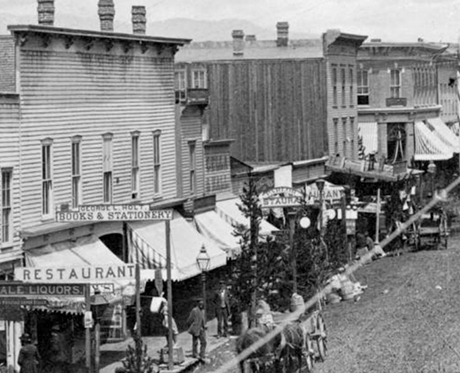
This photograph shows the line of small shops where Abraham would later open his first store on Harrison Avenue. The evergreen trees are a festive addition for the visit of former President Grant in the summer of 1880. When Abraham’s store was burglarized in 1889, a similar set of trees were set out for Fourth of July celebrations, which hid the thieves from view.
From: http://digital.denverlibrary.org/cdm/singleitem/collection/p15330coll21/id/10131/rec/87
By September of 1886, Abraham had made enough money and organized his funds to publish a humble advertisement in the Leadville Daily/Evening Chronicle. The rest of the year did not duplicate the wild year of 1885 and Abraham is not listed in any court cases or the victim of any nefarious activity until the summer of 1887.
Starting in 1887, “Hymie” (Hyman) appears as a separate entry in the city directories. According to his birth year range of 1868-1870, he turned between 16 or 18 this year and as a result was considered independent for placement in the directory. He was listed as a clerk at his father’s store on Harrison Avenue and began his nearly 40 year career as a merchant. The family continued to live at 117 or 119 Harrison Avenue. According to a lot sale in 1890, Abraham also owned 113 and 115 Harrison as well. [25] With the exception of 113 and 115, these hovel-like stores were single story buildings, some members of the family must have lived in quarters behind the storefronts, or perhaps above 113 or 115. A few of them also lived at 114 Chestnut street. The city directories in the middle and late 1880s do not precisely list the residence place of the Isaacs family, and simply list the business location. It is also possible the family lived at 110 Chestnut, as Abraham owned that structure until it burned in 1907. It cannot be accurately determined exactly where the family lived until 1900, as the 1890 census is lost, and the directories are unspecific on the matter. The family likely relocated a number of times while maintaining the business on the 100 block of Harrison.
In August of 1887, the Leadville Daily/Evening Chronicle reported that a barber shop on West Chestnut had been nearly gutted by “cracksmen” thieves. The barber reported the loss of a number of items including some unique and valuable clothing and hair clippers. The police went directly to Abrahams store at 117 Harrison and recovered nearly all of the items reported stolen. It was clear that Abraham was not surprised by the transaction and took the police directly to the men he had bought the goods from, who were loitering on the avenue. The reporter elaborated about the theives’ appearance,
“…They both resemble graduates from the Gotham school of crookedness, however, and should find lodgings in the pen. As an illustration of the encouragement that is offered these characters the transaction that took place at Isaacs’ shop is perfect… Seeing an opportunity to bear the market, the purchaser (Abraham) offered 50 cents. In haste to get rid of these witnesses, the visitors accepted the offer, and unloaded their harvest right there. How much longer this license will be allowed this class of dealers is beyond the honest man’s conjecture. Cases of a corresponding nature have been reported every day for years, while it is a positive fact that the report of any loss is followed up by the authorities by a careful search through these shops. Smith and Collins are regarded as only two of a powerful and fearless organization of cracksmen, who are working the city, and who will doubtless avail themselves of the excitement during the tournament to descend upon the residences that are beyond the regular beats of the patrolmen.”
The debate about the business conducted by “fences” continued for years after this incident and, as 1887 became 1888, Abraham was again enveloped in the issue of illegal clothing exchange. In the summer of 1888, the Leadville Daily/ Evening Chronicle published the following list of ordinance violators,
“For Violating the Law, Mortiz Zieler, A. Isaacs, A. E. Tullock, S. P. Brown, P. A. Newton, and J. Kurtz, second hand dealers were to-day fined 5$ and costs each before Judge Long for violating the pawnbrokers ordinance in not registering the names of people from whom they bought goods.”
The stakes remained relatively low and clearly pawnbrokers were willing to risk the fine in leu of registering their patrons or paying a license fee.
The year 1888 would be more socially active for Abraham and the family. In late August, Ben Davies, cantor at Temple Israel, hosted a ball at City Hall for Jewish residents of the city. “Mr. Abraham Isaacs” and “Mr. H. Isaacs” were listed as attendees. “H.” could have been either Harry or Hyman, but was more likely Hyman as he was older than Harry by several years. In September, Fanny and Abraham hosted members of the “Congregation Bicker Cholom” in their house. “Bikur Cholim” is a mitzvah attendance to the sick which is conducted by many Jewish congregations. The exact intent of “Bicker Cholom” as described here is unknown. It is likely an early incarnation of the Knesset Congregation which conducted Orthodox services in Leadville starting in the middle to late 1880s and moved into the Old Presbyterian church in 1892. [26]
In the summer of 1889, Abraham’s store endured another robbery. Thieves simply entered the store through the front door, as the lock was broken. That night, a row of festive evergreen trees placed along Harrison avenue to celebrate Fourth of July blocked the buglers from detection on the otherwise crowded avenue. [27] In August that year, Abraham purchased the “Milwalkee Brewery” near Malta from Jacob Schloss for $50. Any other mention of this transaction or operation of the brewery has not been found.”
The year 1890 lacked the court cases and criminal drama of previous years and Abraham was only listed in reference to a few land transactions. The city aldermen also approved Abraham’s plan to build a coal shed behind 117 Harrison Avenue in the early spring. [28] During these years Abraham’s court cases and obvious storefront on Harrison Avenue gained Abraham some notoriety, as written caricatures begin to appear of the shopkeeper as early as 1891. That year the Herald Democrat published a quote from Life magazine stereotyping immigrant and specifically Jewish shopkeepers.
“Driving Away A Tennant
‘Another point Mr. Isaacs, this building is absolutely fire proof’
‘Oh, mine krashfus. Idt vuold nefer do. Dhere ish no money in dher glodins peeziniss vidout a foyer vunce in a vhile’
The year 1890 was also the first time Harry was listed in the city directories. This would correspond with his 17th or 18th birthday to qualify as a separate listing from Abraham in the directory. He lived at 119 Harrison Avenue and his profession was listed as painter. [29]
In the spring of 1891, a man named John Clark went to Abraham’s store after a drunken debauch. He intended to sell a pair of shoes in order to gain 50 cents to continue his drinking wallow. After a mis-negotiated agreement, Clark returned after a few days and expected to receive a deposit on the shoes. Abraham refused and claimed he did “second-hand business, not pawn.” Clark went into a rage at Abraham and shortly a constable on a beat approached. The constable urged Clark to move on, but Abraham insisted Clark be arrested for his tirade. Clark was taken to jail for breach of the peace and released immediately on lack of evidence. The remainder of 1891 remained quiet when it came to Abraham’s listings in the newspaper. [30]
Abraham would again find himself in and out of court and surrounded by strange and unscrupulous dealings in 1892. In the spring, Fanny was reportedly arrested for violating a garbage ordinance. The matter was dismissed when it was discovered that Abraham’s wife had not received a notice it was illegal to dump ashes outside. Fanny was fined and returned home. [31] In March, daughter Dora was married in a ceremony conducted by Rabbi Moses Bitwar at the family store and residence, 118 Harrison. Dora married Max Hyman and they planned to move in and reside with the rest of the Isaacs family at the store-residence. [32] In early June, Fanny and Abraham were listed as attendees of the fourteenth annual Strawberry festival hosted by the Hebrew Ladies Benevolent Association. Patrons enjoyed the classic summer refreshments of lemonade, ice cream, and strawberries. The event took place at the civic meeting hall on East 6th Street known as City Hall. [33]
A few days after the strawberry festival, city officials again visited Abraham’s store and detained him due to lack of a second-hand store license. Like previous instances, Abraham simply paid the $50 fee and gave bonds of appeal. [34] In August, a man named Fred Schriver was arrested for vagrancy, but was released after providing proof that he was employed as a bottle collector for Abraham’s store. [35] Another burglary visited Abraham’s store in December. Ten watches were found in the waistcoat of a man named Henry C. Miller. Several of these were found to have been stolen from Abraham’s store, and the Leadville Daily/ Evening Chronicle elaborated on how Miller chose to defend himself before the judge,
“…When Miller was called upon to tell his side of the story, he reeled off a transparent lingo that brought to the features of the justice a sort of what-does-he-take-me-for expression. The accused said that he had been on a protracted spree, and that on the day of his arrest he was walking along the street, when he suddenly felt and unusual weight in the pockets of his coat tails. He instantly formed himself into an investigation committee of one, plunged his hands into the mysterious folds of his pockets and drew out the watches. His astonishment and surprise were greater than if he had run across the long lost Charlie Ross, and while he was trying to satisfy himself in his own mind whether through some unknown agency he had been transformed into a watch manufactory or had become suddenly bewitched, Marshal Loomis stepped up and showed him where the jail was located. Miller told his story without wincing once throughout his narrative, and when he finished Justice Quigly looked upon him long and studiously. As soon as the big hearted magistrate could recover his breath, he referred tenderly to Miller as ‘my poor child’ and sentenced him to sixty days in the county jail, with the addition of a fine of $50.’” [36]
At the end of December, a true tragedy visited Abraham’s household. Six year old son Meyer was run over by a freight wagon on West Chestnut. He was reported to have surreptitiously hitched a ride on the freight wagon. When the wagon hit a deep ravine on Chestnut Street he lost his grip and was run over. He broke his spine and was taken to a house shortly before he died. [37]
In March of 1893, Abraham took an active role in the ongoing conflict he and other junk dealers were experiencing with the city of Leadville’s license fees. According to the city council report for March 15 in the Leadville Daily/Evening Chronicle, Abraham issued a petition to lower the “junk store” license fee from $200 to $50. Mr. Krell represented Abraham at the hearing and explained the reasoning of the desire to change the fee amount. Abraham claimed that some dealers were charged less than him. The matter was referred to the “license and ordinance committee”. It was later decided by the Mayor that insufficient evidence was presented to indicate some junk vendors were charged more than others and the issue was put aside while it was “looked into”. [38]
April, 1893, brought some more trouble to the Isaacs family. A man named William Cronin was reported by Abraham for using abusive language and causing a disturbance in the store. The cause of the disruption was a repeat of a common issue at Abraham’s store: he had sold a suit of clothes without the permission of the owner. The Herald Democrat elaborated,
“…This seemed to paralyze Cronin’s nerves, and he expressed himself rather vigorously in the family presence and raised a hand as though to strike the senior, but the good wife interposed her adipose proportions and Cronin concluded that it would not be policy to strike. The evidence being sufficient however of his intention to create what the ordinances describe as a breach and disturbance of the peace, he was asked to chip in $5 and tailings to the redemption fund.”
The following month of May, Abraham again came before the city council on the subject of junk store license fees. This time he claimed Mr. Dowbisky conducted business without a license. Abraham also elaborated that a city official had insulted him when he complained of this discrepancy. Again, the subject was noncommittally referred to the city collector and no action was taken. [39] Later that summer, Abraham was issued the more mundane allowance of a building permit for a frame stable near his residence at 120 Chestnut. [40]
In September, Abraham’s married daughter Dora passed away from unlisted causes at the age of 21. She was buried in the Leadville Hebrew Cemetery. [41]
Another written caricature of Abraham and immigrant merchants appeared in the Herald Democrat a week later. This time the jab was far less insulting, but still was likely more than a hint to the way which Abraham conducted himself. The Herald Democrat attributed the quote from a newspaper or magazine called, “The Youth Companion”.
“There is more than one way of making a retort in kind without resorting to the vulgar ‘you’re another’. A Jewish street vender of spectacles and eyeglasses was offering his wares when half a dozen saucy young students stepped up.
‘Keep still: we’ll have some fun with him’ said the spokesman of the party.
‘Shpecktakgles! Eyeglasses- goot vons!’ called the vender.
‘Dot vos goot!’ said the young man.
‘Now, what can you see through these glasses, Mr. Isaacs?’
‘Anything vot you like,’ answered the vender.
‘Ish dot so! Well we’ll see about that.’
He took a pair of spectacles, put them on and looked straight at the dealer.
‘Nonsense! Mr. Isaacs!’ he exclaimed.
‘What have you been telling us? Nothing whatever can be seen through these glasses but blackguards [42].’ whereupon all the other students laughed.
‘Vot! Ish dot so?’ exclaimed the vendor as if in alarm. He took the glasses, put them on hastily and looked at the party of students.
‘My gootness!’ he exclaimed, ‘dot ish so!’
Then the boys went on, but this time they were not laughing- Youth’s Companion.” [43]
A few days later, Abraham complained to city council that water from a city ditch was seeping into the basement of his stores, at 118 and 120 Harrison Avenue. Like other issues which Abraham brought to city council, the alderman referred the concern to a different committee. [44]
The following year was quieter around the Isaacs store. One newspaper mention returned a brief level of drama to the shop keeping family’s already storied career. In August, a group of men were loitering at the back of the store on Harrison Avenue. When “H.” (probably Hyman) told them to leave, he was beaten up. The result was a breach of the peace ticket for the offenders and no further mention. [45]
By 1895, Abraham was looking to expand his store, undoubtably with the help of Hyman and possibly Harry. In March, he published an advertisement for the public to bring $1000 in furniture to his store at 117-123 Harrison Avenue. [46] A few days after he began the furniture campaign, Abraham revived the perennial junk license debate and reported a fellow “junk dealer” for doing business without the license. This time the junk dealer was an Italian named Voletti. The Herald Democrat elaborated,
“…Velotti had been charged with engaging in the junk business without a license therefor. He had quite a number of Neapolitian gentlemen on hand to prove something or other. The court could not quite make out what. Isaacs, the second hand man, was on hand to testify that Velotti had purchased beer bottles from Mike Goldsmith for about one year, and the trouble seemed to be that Velotti had been offering a better price for bottles than Isaacs, hence that gentleman’s laudable desire to get Velotti out of the way. The Italian made quite a vigorous speech in his own defense.
‘I picka de rag and de bone and de bottal. Me pay de mun to Timma de cash. Me get de stuff all time, day or night. When me hab de mun me pay de cash; when me hab no mun me go long road, catcha de snipe, and picka up de scrap. Me am Velotti, everybody know me.’
His honor told the prisoner to bring around his papers and he would look into the matter.”
This is another example of the common use of caricatures to portray distinctive individuals in newspapers of the time. [47] The phonetic accent may be accurate or an exaggeration. The pawn business in Leadville was varied and vivid, and such accounts can allow us a brief glimpse at the world at that time. Like many of these petty crimes and episodes, the outcome is unknown.
Later in 1895, Abraham appeared on a long list of individuals and businesses who contributed to the funds of the “Ice Palace and Winter Carnival Association” in the months leading up to the now well known in event in the winter of 1895-1896. [48] Abraham clearly had a community sense and was often on lists suppliers to the local poor house as the 19th century became the 20th. In the mid-summer of 1895, Fannie was also charged with doing business without a license by a neighboring junk dealer. An inquiry also determined that Fannie claimed that business was done in her name, while Abraham claimed that business was done in his name. This aroused suspicions of embezzlement, specifically with respect to a coat that had been pawned against the wishes of a customer named Mrs. O’Brian. [49] Later that same week, another theft report was turned in on Fannie by Mrs. O’Brian, this time as grand larceny by a bailee. [50] The entire affair, although obscured by time, seems to be the culmination of a long running feud between two businesses, to which the police had been attracted by the characters involved. By August, the case was declared nolle-posqui and was dropped. [51]
In late July that year, the rarely mentioned daughter Rebecca married into the merchant Mitgang family when she married Abraham Mitgang [52] on July 13. [53] The couple would remain in Leadville into the 20th Century, but relocated to Denver by 1910. [54]
Few mentions of the Isaacs are evident in newspapers through the winter of 1896. By the mid-summer, Abraham had renewed a campaign for the public to bring in second hand items. As if a nod to the Velotti bottle debacle the previous spring, Abraham emphasized “Beer bottles 20 cents paid a dozen”. [55]
In 1897, Hyman married Austrian immigrant Celia (maiden name unknown). They would go on to have 3 children, Louis born 1898, Sadie born in 1900, and Lottie born in 1903. There was also an “Infant Isaacs” interred in the Hebrew Cemetery in the summer of 1897, but the parents of this child are unknown. The year 1897 also began the slow process of Abraham’s retirement as a fixture of Leadville’s pawn and secondhand business and the rise of Hyman’s career in his father’s stead. This was most evident in the appearance of the “Mitgang and Isaac’s” store in city directories starting this year. [56] The store was under the new management of son Hyman Isaacs and Abraham Mitgang and shared the address at which Abraham had been doing business for the previous ten years; 117-123 Harrison Avenue. However, an apparent dispute extended Abraham Isaacs’ involvement and gave the family some more dramatic publicity. Abraham Isaacs published the following notice in the Herald Democrat on June 3,
“To All Whom It May Concern, Take Notice,
That my wife, Fanny Isaacs and my son H. Isaacs are not, not are either of them, or any other person in my employ authorized to purchase or contract for any goods, wares, or merchandise, or other things in my name, and that I shall not pay for anything they or either of them may purchase or contract for in my name, or in either of their names. My own personal contracts I will pay and none other.
A. Isaacs
117-123 Harrison Avenue
Dated Leadville, Colo, June 1, 1897.” [57]
Given the determined tone of the notice, the Isaacs family was hardly be a picture of harmony at this time. However, whatever had caused the dispute had dissipated only a few days later. A contradictory note was published on June 13 which read,
“I hereby notify the public that I have sold and delivered to Fannie Isaacs my entire business with stock in trade, goods, wares and merchandise, located at 117, 119, 121, 123 Harrison Avenue, this city. All liabilities will be paid on presentation to Fannie Isaacs.
A. Isaacs
Leadville, June 13, 1897.” [57]
Perhaps Abraham was simply unwilling to give up control of the store; but later revised his opinion. He was clearly a man of strong opinions and strong actions. By the end of the month he officially began to bow out of the business. A notice from June 29 read,
“H. Isaacs and A. Mitgang this day succeed to the business of A. Isaacs. The new firm will pay and collect all debts due the old firm.
Isaacs & Mitgang
117-123 Harrison Ave.
Leadville, June 25, 1897” [58]
Following these notices, Abraham makes very few appearances in the Leadville newspapers. Mentions of the Issacs family changed to revolve around his sons Harry and Hyman, who were now in their early twenties, and making their own lives from what Abraham had built. By 1900, both Fannie and Abraham were living in retirement in Denver. [59]
In 1898, a year after her marriage to Hyman, the subject of Celia’s citizenship was mentioned in a May issue of the Herald Democrat. Leadville had a naturalization bureau and immigration status often was brought up during elections. Celia’s legitimacy was put in question in April that year. In Celia’s case, city council reviewed Celia’s right to vote and decided the following:
“…The committee finds that the said Celia Isaacs is entitled to a vote, her husband being under age at the time his father became a citizen through proper naturalization, thereby making her husband a citizen and her marriage to a citizen naturalizes her. We therefore recommend that her vote be allowed.” [60]
Throughout 1898, Isaacs and Mitgang regularly published advertisements in the “Wanted” section of the newspaper. The advertisement here is from a March issue. [61] At the end of November, evidence of Abraham Isaacs’ fame or infamy became apparent at a Masquerade ball. The ball was put on by Mrs. Towne at her dance academy on West Chestnut. Attendees were listed with costumes of, “Columbia”, “Uncle Sam”, “Dainty French Maids”, “A Gypsy Queen” and, most interesting to this study, “Uncle Isaacs the Pawnbroker”. It is clear that Abraham’s eclectic career had distinguished himself in Leadville enough to be emulated in a costume. [62]
By 1899, Hyman began to encounter some of the same troubles and shady characters his father endured in the pawn and secondhand business for years before. In March a man was convicted of selling stolen blankets in Hyman’s store. [63]
A larger issue met Abraham Mitgang and Hyman at the end of 1899, however. In December, a report of stolen brass and fixtures from a nearby mine sent police to investigate pawn shops along Harrison avenue. When the stolen brass was found in a backroom of Hyman and Mitgang, both proprietors were taken to jail. [64] Isaacs and Mitgang plead not guilty to larceny, claiming they were not aware the items were stolen. [65] At the end of December, Isaacs and Mitgang were not charged with the theft, but two boys were convicted of stealing the pawned brass, and were sentenced to the State industrial school. [66]
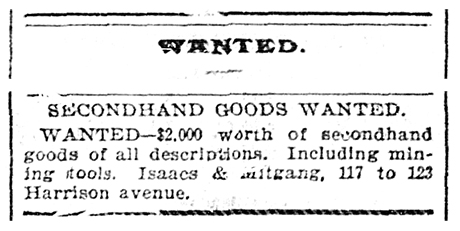
Wanted advertisement for Isaacs and Mitgang.
The Herald Democrat. March 19, 1898. Page 4.
The new century dawned on Leadville and more life and events surrounded the Isaacs. On the afternoon of January 15, a fire burned a large section of the 100 block of Harrison avenue. The Sandusky family were also affected by this fire, which originated in rear of their store. The total damage was reported as $6,000, which was only partially insured. It was also reported that Isaacs and Mitgang suffered the relatively small loss of $500 in goods. The Carbonate Chronicle credited firefighters with saving the entire block from burning. [67]
On January 17, two thieves entered fellow Jewish merchant M. Mankuss’s store on West 2nd street. While one distracted Mankuss with a request to be measured for a pair of “pantaloons” the other stole a jacket and several other items. Mankuss noticed the suspicious activity however and called an alarm. Harry Isaacs and M. Abramson were nearby to help Mankuss and succeeded in detaining the thieves until the police arrived. When the thieves were searched further, they were also found in procession of clothing stolen from yet another Jewish clothing merchant, J. Harwitz. [68]
In the early spring of 1900, new child came into Hyman’s family. On March 16, 1900, Sadie was born at the family residence of 209 West 3rd Street. [69] A week later, the case involving the stolen brass and copper from the previous December was dropped by the district attorney. Isaacs and Mitgang were not charged with any crimes. The two boys who had been sentenced to the industrial school in December were dropped from the case after they had “shown good behavior”. All of the stolen property was returned to the St. Louis Smelter and a local mine. [70] The issue had endured for nearly one year, demonstrating the seriousness of metal theft in early 20th century Leadville.
In the late summer, a freight wagon belonging to Isaacs and Mitgang nearly caused an accident on Harrison avenue. The Carbonate Chronicle elaborated:
“A delivery wagon belonging to the firm of Isaacs and Mitgang was being driven up Harrison avenue at a pretty lively gait when one of the shafts became detached and the horse started to plunge violently. He was soon calmed however, and serious results averted.” [71]
The issue of stolen goods continued to plague Hyman Isaacs and Abraham Mitgang in much the same way it had plagued Hyman’s father. It will never be known how many instances of actual nefarious dealings were conducted by Isaacs and Mitgang. It is clear however, that they often did not consider the providence of goods and individuals with whom they did business. In April of 1901, a man sold a number of goods while they were still mortgaged with Isaacs and Mitgang which landed him in jail. [72]
Three weeks later in the late spring of 1901, both proprietors of Isaacs and Mitgang were again arrested for accepting stolen goods. This time, a man sold them an ore cart, matching iron track, and assorted pieces of brass. Hyman was charged with larceny as it was reported that he was seen hauling the items from the nearby mine to the store on Harrison avenue. Both Isaacs and Mitgang paid $500 bail. [73] In June, the court found Hyman guilty of receiving stolen goods and larceny and two other men were found guilty of stealing the ore cart, brass, and track. It was testified during the proceeding that Hyman had been warned about buying items from a man named McLean who was a known thief. Hyman claimed he would never have bought the ore cart if he knew it stolen and stated, “No man…would deliberately throw away $12.” Mitgang was dismissed as it was found he did not participate in the incident. The total value of the items was stated as $16 dollars. Hyman was returned to jail. [74] On July 2, a petition circulated among Hyman’s friends for his release from jail to simply pay the fine and costs of the incident. It is unknown if this petition was successful.
By February of 1902, Hyman nearly involved himself again in a stolen goods when a man tried to sell him a stolen harness. Hyman refused to buy the item and the Herald Democrat reported he decided the price was not enough. He had either learned to filter nefarious clients or had a lucky break from another possible run-in with stolen goods. [75] In May, Harry was fined $7.85 for after he “administered the beating” to Charles Engle over a debt of 90 cents. The reporter used a reference to Harry’s bookkeeping profession to write a facetious account of this incident:
“…If Harry Isaacs is a good bookkeeper he will make following entry in his ledger:
Paid Court Costs…$7.75
Paid fine… $1.00”
After 1902, evidence of criminal activity around the store begins to diminish and for several years both Hyman and Harry, as well as the business, are quiet. The directories list Harry as a clerk for Isaacs and Mitgang until 1904, when he apparently moved into his own store at 219 Harrison Avenue. [76] Hyman continued to oversee the store at 117-123 Harrison avenue until 1904, when Mitgang was stuck from the name of the store and it transitioned to “A. Isaacs and Son” from 1905 to 1907. Abraham Isaacs rejoined his son in 1905 in the business and lived again at the family residence of 114 Chestnut street. He again returned to Denver in 1907. [77]
In the summer of 1903, Fannie, who was living in Denver by this time, sold a house at 110 Chestnut street to Hyman Isaacs and his colleague Mitgang. According to the 1895 Sanborn fire insurance map, this was a large two story wood frame structure, with a storage area on the first floor and residential rooms on the second. This building would partially burn four years later.
On a cold day in December of 1903, a man stole several pairs of gloves from Harry’s store. The Herald Democrat elaborated,
“…Malone it is alleged was walking by the front of Harry Isaacs’ store yesterday when he felt his hands becoming cold. He saw some nice new gloves and heavy mittens hanging in front of the store and its alleged he decided to try them. He secured five mittens, it is alleged, when the proprietor of the store was not looking.”
The thief was charged with petty larceny. [78]
In May 1905, Hyman took in an orphan girl named May Mitchell who was fleeing an abusive mother. She had been transferred to several different families in Leadville before she was placed with the Isaacs. She did not live with them long and was found to have run away to Wheeler (present day Copper Mountain) earlier in the year. When she was brought before a judge after running away from the Isaacs, she begged to be sent to a “Girl’s Industrial School” in Morrison, which the judge granted. [79]
No newspaper articles about any of the Isaacs family were found during the year 1906. In November of 1906, a child named Lillian was buried in the Hebrew Cemetery. Her parents are unknown and could have been either Hyman and Celia or Harry and Anna. Business continued on a quiet scale during this year at Hyman’s store at 117-123 Harrison and Harry’s store at 209 Harrison.
In 1907 a fire partially burned an Isaacs family building at 110 Harrison avenue. Most of the wood frame buildings in Leadville’s commercial districts were built during 1878-1880 and deferred maintenance and careless fire treatment would claim many of them in the ensuing decades. The Herald Democrat elaborated on the 1907 fire,
“…The origin is a mystery. Excitement over the blaze was started by someone firing several revolver shots into the air, by way of attracting the police. The alarm was turned in and but for the prompt arrival of the department the loss might have been greater for a large rooming house across the alley was in the path of the flames.” [80]
In the fall of 1907 fire again visited the west side of Harrison avenue between 2nd and 3rd street. This centered primarily on the store of Jewish merchant Jacob Harwitz [81]. During the blaze, a number of looters arrived to attempt to carry away clothing items in Harwitz’s store. Harry Isaacs was posted as a guard and the Herald Democrat elaborated,
“…A fellow was seen hurrying from the Harwitz store carrying three pairs of shoes that he had stolen. He was promptly hit and knocked down by Harry Isaacs who was near the door, but Isaacs in turn received a blow on the eye which prevented his holding onto the thief. He succeeded in saving the shoes…” [82]
In the summer of 1908, Harry was once again the victim of another theft. “Sneak thieves” stole a number of firearms from his pawn shop at 209 Harrison. [83] Sometime during 1908, Hyman moved his storefront to 205-209 Harrison avenue. It is to be noted that the Isaacs family had been doing business in and around 117 through 123 Harrison Avenue since 1885. The reason for the move is unknown, but it can be traced by entries in the Leadville City directories.
As 1908 became 1909, newspaper notices and events in the Isaacs’ world became less turbulent. Harry became more of a fixture for events and society. In early spring he returned from a trip to Chicago and New York. He had presumably been there on business, as he reported a strong economy, but the exact reason for the trip was unspecified. [84] In October, the Knesseth Israel congregation hosted a New Year’s Ball, which Harry attended. Harry was also listed as the president of the congregation at the time. Other important families in Jewish Leadville, including Sandusky and Flaks, also appeared at the ball. [85] Hyman’s wife Celia made a visit to Denver for the holidays in late December. [86] This fell within the timeframe of Christmas and Celia was presumably visiting friends. As 1909 dawned, two episodes of thievery and forgery visited Hyman. In February, an itinerant thief stole a pair of pants from Hyman’s store, as well as several others along Harrison Avenue. [87] A few days before Hyman also reported that he had accidentally cashed a forged check. The perpetrator went by many aliases, and one of them was Charles Miller. He had forged a number of checks around the country by the time he was caught in Colorado. One he had tried to cash with Hyman was for $14. [88] As is well established in this study, petty crime was common on Harrison Avenue among the clothing dealers.
In August, a dispute arose between Hyman and the water company of the City of Leadville. According a city council report, Hyman complained that he was double charged for water at his residence and his store. He was seen by a council member carrying water from his house to the store, which triggered the charges. [89] On the 25th of August, the water company completely turned off Hyman’s water as a result of the dispute. [90] The superintendent had ordered Hyman’s water shut off after he witnessed the shopkeeper using water from his house to clean the windows of the store. Given the minor nature of this accusation, it is likely that both Hyman and the superintendent were strong willed and hot headed. The elaboration of the dispute also noted that residents at 118 Chestnut Street had been seen using water from Hyman’s house, which further aggravated the dispute. On September 1, Hyman and the water company came to terms under which Hyman would agree not to use water from his residence at his business. It was agreed that Hyman would use water from a public water wagon for his business and use his residential water solely at his house. [91] The discussion of the issue in the Herald Democrat added up to several paragraphs. This is primarily an interesting insight into the workings of water in Leadville during the early years of the 20th century, as well as Hyman’s stubbornness.
In March of 1910, eight boys were arrested for attempted burglary of a warehouse with an unidentified address “in the south part of town” which belonged to Hyman. [92] This could be a reference the “Milwakee Brewery” Abraham had purchased nearly 20 years before.
Harry relocated his store around 1910 to 423 Harrison Avenue, which was in the southernmost commercial street level unit in the Union Block. One of the advertisements for this new enterprise is shown to the right.
In the late summer of 1910, fellow Jewish tailor and clothing merchant Samuel Flaks [93] died and Harry, along with several members of the Knesseth congregation, acted as pall bearers. [94]
By October, Harry was in full gallop with his newspaper advertising; one example on October 2 took up all of page 7 in the Herald Democrat and boasted a wide array of discounts on clothing which ranged from gloves, union suits, and sheepskin coats. [95] Later that month, Harry was elected to the position of treasurer of Knesseth Israel; he had presumably stepped down from his position as president. [96]
The growth and successes of Harry’s store in 1910 were dashed in early January of 1911 when all the goods in his store were auctioned at an “insolvency sale”. [97] By the middle of January Edward Murphy, trustee, posted a notice that $3,000 in goods were transferred to M. B. Miller. [98] On a half page advertisement from the end of the month, Harry announced a “bankrupt sale” complete with flourishes of “slaughered goods”, “BUSTED”, and “CLIMAX OF FEROCITY” as titles. [99] It was an odd sale, given the fact that M. B. Miller was announced as the highest bidder on the goods nearly 2 weeks earlier, and no mention of Miller is apparent. In March, “Harry Isaacs Clothing” is listed as the victim of another theft of pants; clearly the insolvency did not prevent Harry from using his name in the store or working there. [100] Harry disappeared from Leadville City Directories after 1911. He appeared irregularly, in 1916-1917, but it is clear he would no longer make Leadville his home. He and Anna eventually moved the Chicago area, where they would spend the rest of their lives.
Although an announcement could not be found in Leadville newspapers, Hyman and Harry’s mother Fannie (Faye on her gravestone) died on March 2, 1911 in Denver. She was interred in Rosemont Cemetery in Commerce City. [101]
There was some conjecture over the citizenship status of Hyman in 1912. Despite the aforementioned 1898 question of Celia’s citizenship status, Hyman was apparently still not naturalized properly until 1912. In August he applied for his “final naturalization papers” from the district court. The nation from which he is listed as an immigrant was England, because he was born there as the Isaacs made their way to America from Poland. Along with immigrants from Canada, Ireland, Finland, and Nova Scotia, he applied for his papers in August. [102]
In November, he attended and was a pall bearer for the funeral of M. Zieler, the pioneer merchant. The Herald Democrat elaborated,
“…The impressive burial ritual of the Jewish church was read by M. B. Miller, assisted by Harry Mamlock. Many beautiful floral offerings were sent by friends who sympathize with the bereaved members of the family…” [103]
Prominent Jewish merchant Louis Greenwald died in March of 1913 and Hyman was again listed as a pall bearer. A large contingent from the Knesseth congregation was present as well. [104]
Trouble again visited Hyman in the form of an unprovoked fight in the spring of 1913. Frank Cosseboom had bought some clothes at Hyman’s store for credit. After several months, Hyman visited Cosseboom’s boarding house on Toledo street to collect what he was owed. The Herald Democrat elaborated:
“Isaacs said Cosseboom went indoors after saying he was going after the money, however, it was said, Cosseboom came out again with the clothes for which he owed Isaacs and tossed them all into the yard. After that he pushed Isaacs off the steps, following him and beating his face black and blue…”
This resulted in a short trial and Cosseboom was convicted and fined. [105] Two days later one of Hyman’s clerks named Mira Steger “used offensive language” and slapped Elsie Mankuss in front of the store on Harrison Avenue. The Herald Democrat elaborated:
“…Steger at the time was unpacking some new merchandise boxes in front of the store, he said. He testified that ‘Her father came and told me why I strike his daughter. But I didn’t know, I slap nothings.”
His testimony would not hold, and the court fined him $10 and costs, after City Attorney McLeod had examined him. The complaint against him was sworn out by the girl’s father, I. Mankuss who was present in court as a witness…” [106]
Hyman would gather unused and unwanted furniture from around Leadville throughout his career. In late October he made a trip to the smelter worker’s suburb of Stringtown to buy unused furniture. Although his specialty was clothing and household goods, he still had interest in second hand furniture. [107]
By November of 1914, Hyman had outgrown his second storefront on the 200 block of Harrison Avenue. He moved into to a large two story block at the northwest corner of 3rd street and Harrison. [108] He would remain there for another 5 years. Hyman’s son Louis turned 16 or 17 in 1914 and began to take a role in the store at this time as well.
The First World War was entering its first winter in November of 1914 and American relief organizations around the country began sending relief to war torn Belgium. Leadville was no exception and on November 27th a list of donors was published in the Herald Democrat which included Hyman Isaacs and other businessmen such as J. W. Callaway, proprietor of the Delaware Hotel. [109] By this time, Hyman had begun to move away from the second hand trade and an advertisement for a piano playing contest at the store listed him as a dealer of “household furnishings, ranges, etc.” [110] A few days later, Hyman, along with fellow Jewish merchant Jacob Grossmeyer, put in a bid to supply the county government with stationary. [111] Clearly Hyman was making efforts to remove himself from the tumultuous second hand trade.
Hyman’s daughter Sadie began to appear regularly in newspapers by 1914. Like her contemporary Ethel Sandusky, Sadie was a prolific singer. While not a professional like Ethel, she first appears in Leadville newspapers as a participant in the birthday festivities of Helen Walpensky, where she sang a song. [112] In March, she was listed as a member of the Laurel Club, and she often sang songs for the group. This was an Irish club based at the High School and was primarily made up of Irish girls. Clearly, Sadie took an interest and sang famous Irish songs of the time, “Has Anybody Here Seen Kelley?” and “Where the Shannon Flows”. [113] Sadie was also active in a debate group known as the Castillians. [114] In May, she was also active in another group, known as the GTS Club, which conducted outings and picnics. [115]
Starting in 1915, Hyman began to advertise daily in the Herald Democrat. Items which appeared ranged from stoves to clothing and household items. The store began to take the shape of an early 20th century equivalent of Target or Wal-Mart. These ads would run regularly on a weekly and daily basis well into the 1920s. In late January, another club which Sadie participated met at the residence of Leah and Ethel Sandusky on 5th Street. Many of the other girls present were also from Jewish families such as Amter and Mankuss. [116]
Despite the success, thieves still lurked in the shadows. In January 1915, a night watchman foiled two robbers who had walked into the basement furnace room at Hyman’s store. Stoves at that time were regularly stoked by a “fireman” and, in the case of Hyman’s building, the fireman had broken the lock to the basement door and it was wide open. This allowed the burglars easy access before they were caught by the night watchman. [117]
Hyman’s son Louis made his first appearance in Leadville newspapers in 1915 in the cast of a play at Leadville High School. [118] The previous year he was photographed with Hyman’s store manager Mike Philips, suggesting he had begun to work at the store at that time. According to his birthday of November 1898, Louis was between 16 and 17 at the time.
By 1915, prosperity had finally begun to materialize for Hyman. In the mid-summer, he bought a Reo Touring car, a purchase that was important enough to make the social column of the Herald Democrat. [119] Several weeks later it was announced that Hyman and Celia intended to make a “motor-trip” to Denver via “the Pueblo route”. [120] This trip predated the highway system by decades, and the northern route through the central mountains via Summit county was still the sole territory of the railroads. The route the Isaacs took probably followed an old stagecoach route south along the Arkansas river and was a several days affair. A motor trip like this was very fashionable and certainly not a regular occurrence for a Leadville merchant family.
In July, the Herald Democrat took a poll of opinions regarding the celebration of Independence Day. Hyman was one of the business owners polled and he expressed:
“I feel a great deal like the editorial in the Herald Democrat. I think we ought to have a little get-up and enthusiasm about us: give a little celebration; show our patriotism and keep the people at home. I can contribute a little again.” [121]
In September, Hyman’s oldest daughter Sadie left Leadville for school in Denver. [122] This may have been a preparatory school or perhaps Lake County public school was not suitable for her. She would later move to Chicago.
As 1915 came to a close, Hyman joined other Harrison avenue merchants in a lively display for the Christmas holiday and showcased a display of furniture. [123]
Prosperity continued into 1916. Hyman published nearly daily advertisements throughout the year for items as varied as cook ranges, suits, baby carriages and furniture. The focus remained on furniture however, and most ads touted “carloads” filled with tables, desks, and couches which Hyman regularly received at the store.
In January 1916, Hyman attended the funeral of Hannah Oliner, the wife of Herman Oliner. The services were likely conducted at the Knesseth building on 5th street. [124] In the winter, Hyman had a sleigh based delivery service, probably for collecting and delivering furniture. On the cold day of February 1, 1916, one of Hyman’s men was delivering a load to a house on East 6th Street when according to the Herald Democrat, “…the animal decided the weather was too chilly to wait for its driver…” and ran away with the empty sled. As it rounded the corner at Harrison and 3rd the runaway struck a grocery delivery vehicle and caused a great deal of groceries to be knocked into the street. The horse eventually became tired in the deep snow and was caught at the intersection of 5th Street. [125] A second runaway in March passed in front of Hyman’s store and knocked over a public drinking fountain. [126] In the early spring, the county listed Hyman’s store as a supplier for the county poor house in the amount of $5.50.
In October, a strange accident occurred in Hyman’s store. A revolver on display in Hyman’s store was accidentally discharged during a demonstration by an unarmed clerk. The bullet hit two men and both were injured. Jerry Marold lost an index finger as the bullet ricocheted around the store. Another man named Max Hart was hit in the chest, but the bullet had lost momentum and he was only bruised. [127]
The next month Hyman reported one of his clerks for stealing suits from the store. He was held for a few weeks. By the time the court date had arrived, it was realized by the district attorney that the men who were primary witnesses were scattered around the west, in Montana, Denver, and Missouri, and to bring them back for an unknown testimony was not worth the effort. Thus the clerk was released and the case dismissed. [128] That same week, Hyman purchased a house for taxes located on the 100 block of West 3rd Street. [129]
Harry returned to Leadville briefly in 1916 and 1917. His store was located at 407 Harrison Avenue those two years and was listed as “Model Clothing Store”. [130] By 1919, Harry was again absent from Leadville. Hyman continued to advertise extensively and once again almost daily advertisements appear for household items and furniture.
In August, Harry’s 14 year old son, Maurice, accidentally shot his playmate Alpheus Reed with a .22 caliber rifle. The wound was not severe and Maurice claimed he thought the rifle was not loaded. [131] A few days later, Alpheus was reported to be in good condition and the bullet had not “passed through the vital part”. [132] No further mention of the incident could be found and the boy likely recovered.
In September, Hyman advertised a $5 trip for two or three passengers to Colorado Springs or Denver in his 7 passenger Reo Touring car. This was likely an early carpooling effort instead of a full commercial effort of Hyman’s, one which he tried to make up some of the cost of the trip by charging passengers. [133] That same month, Harry’s eldest daughter Hellen departed Leadville to attend school in Chicago, probably with her cousin and Hyman’s daughter Sadie. [134]
The war in Europe was about to enter a 3rd winter and the Jewish community of Leadville under the leadership of J. Ampter, Ethel Sandusky, and Harry Isaacs joined a national Jewish campaign to raise $10,000 for war sufferers. In conjunction with Yom Kippur services at Knesseth Israel in early October, Harry and Ethel were appointed to direct and organize donations toward the campaign. [135] As a continuation of Isaacs family charity, Hyman donated a furniture display for a Red Cross concert and play in November. [136]
Prosperity returned for Hyman in 1918 as evidenced by more daily ads in Leadville newspapers for his store. Early May found Hyman on a business trip to Denver. [137] In October, trouble visited Hyman when a rental house he owned at 305 Spruce Street burned down. The renter had accidentally set her mattress on fire but had reportedly doused the blaze. An hour later she was taken to jail, suspected of “violating the city ordinance requirements for women on the streets”. In the hours while the renter was away, the mattress shouldered and was “lit anew”. The house burned to the ground. [138]
Tragedy struck the world in the form of the influenza epidemic in early October of 1918. The disease first appeared in Leadville around October 3rd. As with many Leadville families, the Isaacs fell victim of the sickness when Sadie died in Chicago in early November. [139] Like many victims of this strain of flu, she was in young adulthood at 18 years of age and otherwise healthy. While her death was in Chicago, over 200 deaths would be reported in Leadville before the spring of 1919-nearly all young adults. On the day of Sadie’s funeral notice, twenty other funerals were listed in Leadville. A further six deaths were reported the previous day, November 10. Even as the war in Europe was coming to an end, several Leadville men were among those listed as killed in action during this same week as well. [140] Sadie was brought to Commerce City and buried in the family plot at Rose Hill Cemetery. [141]
Hyman again began 1919 with prolific advertisements and new events in the store, but the early spring brought a new challenge. On the morning of May 6, the south wall of Hyman’s store at 301 Harrison Avenue collapsed into west 3rd Street. The building was nearly 40 years old at the time and a brick facade which was installed over the original frame construction could have contributed to rotten second story support members which lead to the collapse. The aftermath of the collapse was captured on camera, as shown here. The Herald Democrat elaborated:
“‘The Smith Block’ at West Third street an Harrison avenue, where the commercial success was made which later brought prosperity to the Daniels and Fishers Stores company at Denver and before which stage loads of dry goods used to be sold before they could be removed to the store shelves collapsed at 7 o’clock yesterday morning, miraculously failing to injure any of a dozen roomers in the rooming quarters on the second floor or any of the employees of the Hyman Isaacs department store on the ground floor.
Relic of the boom days of ’79, when the building was erected with lumber and a structure to which a brick veneer had been added to give it a more modern appearance, the ‘Smith Block’ had had doubtful stability for several years. Action by the city council a year ago led to bracing of the south wall, which was the weak point yesterday morning when the structure began to collapse. This wall swung out into West Third street, the roof and front wall fell inward. The fact that the north half of the building sank only a few feet and did not double up saved a large part of the furniture stock of the Isaacs store from damage.
Roomers on the second floor, which was conducted by Mrs. Lillian Reed as a rooming house, were warned of the impending danger in time to escape though virtually all of them lost the personal effects. Mrs. Reed’s possessions were all badly damaged.
There were ten roomers on this upper floor. Part of them were getting up for the day when the south wall began to creak. Mike Philips, chief clerk at the Isaacs store, who had just come to work, heard the creaking and ran upstairs in time to awaken William Yates, owner of a candy and lunch wagon on the corner near the store and others. Chris Ball, a miner was just dressing when he heard the warning cracks. Joe Piazzi, a restaurant waiter, got out barely in time, as did also Pete Martin, who was asleep when the first crack sounded…
…Hyman Isaacs, owner of the department store, estimated that his loss will be about $10,000. The main damage affected his men’s clothing department which was situated on the south side of the building. During the rest of the day he and his son, Phillips, Bradley T. Wilson, bookkeeper at the store and numerous employees removed much of the buried goods to new quarters after the shovelers had cleared away the piles of brick and plaster.
The store owner secured temporary quarters in the Star Block, one block north, and the former Frantz store building adjoining, last occupied by Mr. Isaacs brother Herman [sic Harry] with a clothing business. Mr. Isaacs said he will endeavor to remodel these two structures into suitable quarters for his business, and possibly also make use temporarily of the old D. & R. G. city ticket office building, West Fourth and Harrison Avenue, where some of the salvaged goods were stored yesterday.
No insurance was carried against such damage as the cave-in caused…” [142]
After only 5 days, Hyman already published a new address for his store in the Star Block. [143] Following the collapse, Hyman took advantage of the situation to host an aptly named “Wreck Sale” in his new storefront that summer. It was an adaptive version of the “fire” or “flood” sale common to dry goods stores of the time. The sale began in early June and appealed to “bargain hunters” and expected “crowds” to swarm the new store. [144] That summer brisk sales continued and such items as Red Wing shoes were advertised. [145] In the early fall, Hyman purchased the stock of another Harrison Avenue merchant named Alf Hoffman of the Hoffman Toggerty. [146] The purchase would be followed by a series of financial conflicts between Hoffman and Hyman in the following years.
According to the United States Census, the 1920s saw a decline in population and prosperity for Leadville. The 1920s also dawned with uncertainty and some tragedy for the Isaacs family. On January 12, the Carbonate Chronicle reported the death of patriarch Abraham Isaacs. He was reported healthy until a short illness and “Bright’s Disease” quickly eroded his health. The report gives insight into the locations of his children in early 1920. Harry was in Chicago, Betty Mitgang was in Sheridan, Wyoming, and Hyman in Leadville. An unidentified widow is listed; his first wife Fanny died nearly 10 years before, so Abraham had clearly remarried in the intervening years. Details of his early life are revealed and have been covered earlier in this study. Abraham was buried with Fanny and Sadie in the Isaacs family plot within Rose Hill Cemetery. [147]
Despite these troubles and economic woe, Hyman continued to advertise regularly and involved himself again in litigious matters. The move of items from Hoffman’s bought out store was complete by February of 1920 and Hyman published an advertisement indicating bills left with Hoffman could be paid at 405 Harrison Avenue. [148]
A month later however, a tax dispute arose with a third party named Singer. The conflict originated with who between Hoffman, Hyman Isaacs, and Singer was supposed to pay the taxes on the goods that Hyman ultimately acquired and moved to his store. As a result, Hyman filed a lawsuit against Hoffman for the unpaid taxes. Singer, who originally bought the goods from Hoffman, had made an agreement with Hyman that Hoffman was responsible. [149] The results would not become apparent for another year, and no further detail of the suit was published in 1920. In November, Hyman was again listed as a supplier of $2.75 worth of goods for the county poor house. [150] Hyman’s store also displayed a festive holiday display of men’s wear in December. [151]
The year 1921 dawned similarly to 1920. Leadville experienced a post-World War economic slump starting in 1920, which was fully realized by 1921. Mining operations continued and a few new ones opened, but behemoths such as Iron Silver Mining Company closed by the end of the decade. [152] Economic woes did not slow Hyman’s advertisements however. As in the previous several years, Hyman Isaacs’ store was present in daily and weekly advertisements in the Herald Democrat and Carbonate Chronicle. In March, he advertised clothing “At Pre-War Prices”. [153] Clothing dominated Hyman’s sales efforts during 1921 and throughout the 1920s. Most advertisements tout overalls, suits, underwear and hats. Mentions outside of advertisements of Hyman are fewer than many previous years. In April, the social column mentions Louis Isaacs and Fred Johnson, “motored to Denver in the fore part of this week in Isaacs’ Reo car.” [154] Another auto trip in the Reo was undertaken by Louis in October. [155] In August, another foiled theft appeared in the Herald Democrat. Hyman’s store managed by Louis endured an attempted break-in on the morning of August 26. The Herald Democrat intriguingly began,
“Another Leadville safe has withstood the breast drill and tedious labor of yeggmen…”
The thieves managed to steal $5 in cash, a .32 caliber pistol, two suits, a sheepskin coat, and a set of tailor’s instruments, in addition to an unsuccessful attempt at cracking the safe by drilling four holes around the mechanism. The worst insult of the heist, according to Louis Isaacs, was the fact that the “yeggs” wiped their greasy drill bits on a clean clerk’s apron. The article mentioned a new development as well: Louis Isaacs is listed as the manager of the store. [156] It is likely Louis’s father, Hyman, was transitioning into retirement after working as a Leadville merchant for 35 years. With this promotion, Louis became the third generation of Isaacs to conduct business in Leadville.
In late September, an unusual and destructive event visited Harrison Avenue. On the morning of September 30, a restaurant on the 200 block of Harrison avenue was bombed. A charge of dynamite destroyed the “Place to Eat Restaurant” as well as “Steven’s Barber”. An adjoining apartment which was occupied by the Martinez family was damaged, and it was reported that this building was owned by Hyman Isaacs. The Herald Democrat also reported that Hyman was a resident of Denver at the time of the bombing. [157] This supports the retirement theory, as Louis had begun to take over affairs at the store at 405 Harrison. The perpetrator and reason for the bombing remains a mystery.
On November 20, Louis married Charlotte Wolf, the sister of Hyman’s former store manager, Michael Phillips [158]. The wedding ceremony took place at the Wolf residence on Vine Street in Denver. Many former Leadville Jewish families attended including Ethel Sandusky, Maurice Miller, and Max Raabe. During the reception, the Herald Democrat reported, “…was a reading of telegrams from practically every Jewish family in Leadville.” The couple planned to move into a residence at 140 West 7th Street after their Colorado honeymoon. [159]
Louis continued to operate the store under the name “Hyman Isaacs’” throughout the 1920s. As late as 1927, the “Hyman Isaacs” store was still advertising. The final year the store is listed in the telephone directories is 1931. The Isaacs family cannot be located in Leadville’s 1930 Federal Census, however, but presumably Louis or Mike Phillips operated the store until 1931. By 1940, Louis and family were located in Denver. Hyman and Celia’s daughter Charlotte (Lottie) was the longest lived of the Isaacs’ second generation when she died in Denver in November of 1984. Louis had passed in 1964.
Nearly 50 years of plentiful excitement, trouble, and life followed the Isaacs during their stay in Leadville. The most remarkable benefit of their presence in the Carbonate City is the vivid insight gained about the lives of a multi-generational merchant family. The documentation presented in this study is a result of searches in History Colorado’s Newspaper archive and limitations exist in searchable newspapers after 1923. As a result of these constraints and Leadville’s declining economic prosperity, information becomes unclear as early as 1921 and few details are available. From their earliest days in Leadville in the fall of 1882, up through the uncertain years of the 1920s, the Isaacs endured and even thrived in the wild mining city during its most vivid years.
1 Find A Grave, database and images (https://www.findagrave.com : accessed 12 November 2018), memorial page for Lillian Isaacs (1905–18 Nov 1906), Find A Grave Memorial no. 18472131, citing Hebrew Cemetery, Leadville, Lake County, Colorado, USA ; Maintained by Michael Harrington (contributor 46760007).
2 Year: 1900; Census Place: Leadville, Lake, Colorado; Page: 1; Enumeration District: 0044; FHL microfilm: 1240125 Ancestry.com. 1900 United States Federal Census [database on-line]. Provo, UT, USA: Ancestry.com Operations Inc, 2004. Original data: United States of America, Bureau of the Census. Twelfth Census of the United States, 1900. Washington, D.C.: National Archives and Records Administration, 1900. T623, 1854 rolls.
3 “Society” Herald Democrat, June 29, 1913 p. 6 4 Find A Grave, database and images (https://www.findagrave.com : accessed 28 October 2018), memorial page for Charlotte Isaacs Gold (26 Jun 1902–12 Nov 1984), Find A Grave Memorial no. 174107643, citing Rose Hill Cemetery, Commerce City, Adams County, Colorado, USA ; Maintained by SwHoot (contributor 49054756) .
5 Ancestry.com. California, Death Index, 1940-1997 [database on-line]. Provo, UT, USA: Ancestry.com Operations Inc, 2000. Original data: State of California. California Death Index, 1940-1997. Sacramento, CA, USA: State of California Department of Health Services, Center for Health Statistics
6 Sanborn Fire Insurance Map 1883
7 1884 Leadville City Directory p. 121
8 Sanborn Fire Insurance Map 1883
9 For more information on the Sandusky family visit: http://www.jewishleadville.org/sandusky.html
10 Sanborn Fire Insurance Map 1886
11 “Stole an Overcoat” Carbonate Chronicle, January 24, 1885 p.8
12 “Wanted an Overcoat” Carbonate Chronicle, March 14, 1885 p. 6
13 “Justice Court” Leadville Daily Herald, March 15, 1885 p. 4
14 “Marshal Faucett Succeeds in Recovering Fully $250 Worth of Stolen Clothing and Bedding” Leadville Daily Herald, March 12, 1885 p. 4
15 “Minus Twenty Dollars” Carbonate Chronicle, March 14, 1885 p. 1
16 For more information on the Mankuss family see http://www.jewishleadville.org/mankuss.html
17 "Colorado State Census, 1885," database with images, FamilySearch(https://familysearch.org/ark:/61903/1:1:K8WN-XWF : 1 April 2016), A Isac, 1885; citing NARA microfilm publication M158 (Washington, D.C.: National Archives and Records Administration, n.d.); FHL microfilm 498,507.
18 "Colorado State Census, 1885," database with images, FamilySearch(https://familysearch.org/ark:/61903/1:1:K8WN-L6H : 1 April 2016), E A Isicks, 1885; citing NARA microfilm publication M158 (Washington, D.C.: National Archives and Records Administration, n.d.); FHL microfilm 498,507.
19 “Abraham’s Coat of Colors” Carbonate Chronicle, October 24, 1885 p. 7
20 “A Bailee Mulcted” Carbonate Chronicle, October 24, 1885 p. 1
21 “Buckiens Armon Salve” Herald Democrat, January 8, 1886 p. 4
22 “They Will Not Do It” Herald Democrat, January 30, 1886 p. 4
23 “Frozen” Leadville Daily/Evening Chronicle, February 4, 1889 p. 3
24 “Bound Over Forgery” Herald Democrat, April 14, 1886 p. 4
25 “With the Recorder” Herald Democrat, March 11, 1890 p. 5
26 “A Delightful Reception” Leadville Daily/Evening Chronicle, September 11, 1888 p. 4
27 “Bold Burglars” Herald Democrat, July 6, 1889 p. 4
28 “The Aldermanic Board” Herald Democrat, March 5, 1890 p. 4
29 1890 Leadville City Directory p. 120
30 “All For Fifty Cents” Leadville Daily/Evening Chronicle, May 20, 1891 p. 4
31 “The Aldermanic Board” Herald Democrat, May 11, 1892 p. 4
32 “Hyman-Isaacs” Herald Democrat, March 2, 1892 p. 7
33 “Very Pleasant Soiree” Leadville Daily/Evening Chronicle, June 9, 1892 p. 2
34 “Police Court Pickings” Herald Democrat, June 14, 1892 p. 1
35 “Police Court” Herald Democrat, August 5, 1892 p. 8
36 “Miller’s Fishy Story” Leadville Daily/Evening Chronicle, December 7, 1892 p. 1
37 “A Boy Killed” Herald Democrat, December 21, 1892 p. 6
38 “Aldermanic Board” Leadville Daily/Evening Chronicle, March 15, 1893 p. 1
39 “Aldermanic Board” Herald Democrat, May 25, 1893 p. 1
40 “Aldermanic Board” Herald Democrat, June 14, 1893 p. 2
41 “Died” Herald Democrat, September 5, 1894 p. 5
42 A blackguard is someone dishonest or misleading.
43 “One of Them” Herald Democrat, September 14, 1893 p. 3
44 “City Clerk Suspended” Herald Democrat, September 20, 1893 p. 2
45 “Wheels of Justice” Herald Democrat, August 22, 1894 p. 5
46 “Business Bulletin” Herald Democrat, March 17, 1895 p. 2
47 “Police Court” Herald Democrat, March 7, 1895 p. 8
48 “Word as to the Palace” Herald Democrat, September 29, 1895 p. 3
49 “Charged with Embezzlement” Herald Democrat, July 10, 1895 p. 1
50 “Is Once More in Trouble” Herald Democrat, July 20, 1895 p. 5
51 “The Fair Fannie Escapes” Herald Democrat, August 14, 1895 p. 3
52 For more information on the Mitgang family see: http://www.jewishleadville.org/mitgang.html
53 “With the Recorder” Herald Democrat, July 13, 1895 p. 3
54 1910 United States Federal Census
Census Place: Denver Ward 3, Denver, Colorado; Roll: T624_114; Page: 4B; Enumeration District: 0059; FHL microfilm: 1374127 Ancestry.com. 1910 United States Federal Census [database on-line]. Lehi, UT, USA: Ancestry.com Operations Inc, 2006.
55 “Furniture and Bottles Bought” Herald Democrat, June 29, 1896 p. 4
56 1897 Leadville City Directory
57 “Notice” Herald Democrat, June 3, 1897 p. 8
58 “Change of Firm” Herald Democrat, June 26, 1897 p.8
59 1900 United States Federal Census: Denver, Arapahoe, Colorado; Page: 3; Enumeration District: 0006; FHL microfilm: 1240117 Ancestry.com. 1900 United States Federal Census [database on-line]. Provo, UT, USA: Ancestry.com Operations Inc, 2004.
60 “Session of the City Council” Herald Democrat, May 25, 1898 p. 8
61 “Wanted” Herald Democrat, March 19, 1898 p. 4
62 “The World of Society” Herald Democrat, November 13, 1898 p. 6
63 “Stole the Blankets” Herald Democrat, March 29, 1899 p. 8
64 “Found Two ‘Fences’” Herald Democrat, December 4, 1899 p. 6
65 “Collins Convicted” Herald Democrat, December 13, 1899 p. 6
66 “Sentenced to the State Industrial School” Herald Democrat, December 29, 1899 p. 7
67 “Fire on the Avenue Did Considerable Damage” Carbonate Chronicle, January 15, 1900 p. 6
68 “Sneak Thieves” Herald Democrat, January 17, 1900 p. 6
69 “Born” Herald Democrat, March 19, 1900 p. 2
70 “Embezzled the Ore” Herald Democrat, March 29, 1900 p. 1
71 “Nearly A Runaway” Carbonate Chronicle, August 6, 1900 p. 8
72 “Mortgage Fiends” Carbonate Chronicle, April 1, 1901 p. 8
73 “More Revelations in Harrison Avenue ‘Fence’” Herald Democrat, April 28, 1901 p. 8
74 “Bought Stolen Goods” Herald Democrat, June 21, 1901 p. 10
75 “Stolen Harness” Herald Democrat, February 22, 1902 p. 2
76 1900-1903 Leadville City Directories
77 1900-1907 Leadville City Directories
78 “Glad Hand For Gloves” Herald Democrat, December 27, 1904 p. 4
79 “Sad Case of a Girl Afraid of Her Mother” Herald Democrat, May 19, 1905 p. 3
80 “Warehouse Burns” Herald Democrat, October 28, 1907 p. 5
81 For more information on the Harwitz family see, http://www.jewishleadville.org/harwitz.html
82 “Lower Harrison Invaded” Herald Democrat, October 2, 1907 p. 3
83 “Isaacs Store Robbed” Herald Democrat, July 25, 1908 p. 5
84 “Returns From East” Herald Democrat, March 2, 1909 p. 5
85 “New Years Ball” Herald Democrat, October 11, 1909 p. 5
86 “Personal Mention” Herald Democrat, December 24, 1908 p. 5
87 “Stole Isaacs’ Pants” Herald Democrat, February 19, 1909 p. 5
88 “Miller’s Looks Didn’t Fit Age” Herald Democrat, February 14, 1909 p. 8
89 “City Council” Herald Democrat, August 4, 1909 p. 1
90 Objection to Cement Walks” Herald Democrat, August 25, 1909 p. 2
91 “Hyman Isaacs and Water Co.” Herald Democrat, September 1, 1909 p. 3
92 “Boys to be Tried” Herald Democrat, March 29, 1910 p. 5
93 For a brief overview of the Flaks family, visit: http://www.jewishleadville.org/flaks.html
94 “Funeral of Samuel Flaks” Herald Democrat, August 13, 1910 p. 5
95 “Advertisements” Herald Democrat, October 2, 1910 p. 7
96 “Annual Election of Officers” Herald Democrat, October 14, 1910 p. 5
97 “To Whom It May Concern” Herald Democrat, January 9, 1911 p. 5
98 “Filed for Record” Herald Democrat, January 12, 1911 p. 5
99 “Advertisements” Herald Democrat, January 27, 1911 p. 3
100 “Robbery Cases Disposed of by District Court Jury” Herald Democrat, March 10, 1911 p. 3
101 https://www.findagrave.com/memorial/180881806/faye-isaacs
102 “Seek Papers of Citizenship” Herald Democrat, August 4, 1912 p. 7
103 “Funeral of M. Zeiler” Herald Democrat, November 1, 1912 p. 5
104 “Funeral of L. Greenwald” Herald Democrat, March 1, 1913 p. 5
105 “Frank Cosseboom Fined” Herald Democrat, May 11, 1913 p. 5
106 “Paid $21 For Rudeness” Herald Democrat, May 8, 1913 p. 5
107 “Fransisca Chewed and Giggled” Herald Democrat, October 10, 1913 p. 8
108 “Hyman Isaac’s New Store” Herald Democrat, November 10, 1914 p. 3
109 “Belgian Relief Fund Donor” Herald Democrat, November 27, 1914 p. 5
110 “Grand Piano Contest” Herald Democrat, December 25, 1914 p. 5
111 “County Bids are Received” Herald Democrat, December 25, 1914 p. 1
112 “Society” Herald Democrat, January 11, 1914 p. 7
113 “Public School Column” Herald Democrat, March 8, 1914 p. 2
114 “Public School Column” Herald Democrat, December 7, 1914 p. 4
115 “Society” Herald Democrat, May 24, 1914 p. 7
116 “Society” Carbonate Chronicle, January 25, 1915 p. 5
117 “Prevented a Robbery” Herald Democrat, January 31, 1915 p. 5
118 “Christmas Program” Herald Democrat, December 12, 1915 p. 7
119 “Personal Mention” Herald Democrat, June 19, 1915 p. 3
120 “Personal Mention” Herald Democrat, July 7, 1915 p. 3
121 “Responsive to Celebration” Herald Democrat, June 13, 1915 p. 4
122 “Society” Herald Democrat, September 19, 1915 p. 2
123 “Holiday Week Will Be Festive” Herald Democrat, December 27, 1915 p. 3
124 “Mrs. Annie Oliner” Herald Democrat, January 28, 1916 p. 3
125 “Exciting Runaway” Herald Democrat, February 1, 1916 p. 5
126 “Runaway Horse Bowls Over Drinking Fount” Herald Democrat, March 16, 1916 p. 5
127 “Around the City” Carbonate Chronicle, October 16, 1916 p. 1
128 “Larceny Case Dismissed” Carbonate Chronicle, November 27, 1916 p. 1
129 “Legal Notices” Carbonate Chronicle, November 20, 1916 p. 4
130 1916-1917 Leadville City Directories p. 152 and p. 121
131 “Didn’t Know It Was Loaded” Herald Democrat, August 17, 1917 p. 5
132 “Personal Mention” Herald Democrat, August 19, 1917 p. 2
133 “Auto Trip” Herald Democrat, September 13, 1917 p. 4
134 “Society” Herald Democrat, September 2, 1917 p. 2
135 “Relief for Jewish War Suffers” Carbonate Chronicle, October 1, 1917 p. 2
136 “The Red Cross” Herald Democrat, November 5, 1917 p. 6
137 “Personal Mention” Herald Democrat, May 15, 1918 p. 3
138 “Building Burned” Herald Democrat, October 3, 1918 p. 8
139 “Sadie Isaacs” Carbonate Chronicle, November 11, 1918 p. 3
140 “Death and Funeral Notices” Carbonate Chronicle, November 11, 1918 p. 3 141 Find A Grave, database and images (https://www.findagrave.com : accessed 28 October 2018), memorial page for Sadie D Isaacs (1900–6 Nov 1918), Find A Grave Memorial no. 174071864, citing Rose Hill Cemetery, Commerce City, Adams County, Colorado, USA ; Maintained by SwHoot (contributor 49054756) .
142 “Collapse of Building” Herald Democrat, May 7, 1919 p. 1
143 “Wait Just a Few Days” Herald Democrat, May 13, 1919 p. 3
144 “Hyman Isaacs” Herald Democrat, June 6, 1919 p. 3
145 “That’s Why Shoes” Herald Democrat, August 31, 1919 p. 3
146 “Notice to the Public” Herald Democrat, September 14, 1919 p. 5
147 “Abraham Isaacs” Carbonate Chronicle, January 12, 1920 p. 3
148 “Notice” Herald Democrat, February 17, 1920 p. 6
149 “Filed to Collect Taxes” Herald Democrat, March 25, 1920 p. 5
150 “Public Notice” Herald Democrat, November 27, 1920 p. 3
151 “Holiday Times Near At Hand” Herald Democrat, December 12, 1920 p. 3
152 Leadville Colorado’s Magic City p 227-228
153 “Let Us Dress You For Easter”3 Herald Democrat, March 25, 1921 p. 3
154 “Personal Mention” Herald Democrat, April 22, 1921 p. 3
155 “Personal Mention” Herald Democrat, October 2, 1921 p. 2
156 “Yeggman is Foiled Again” Herald Democrat, August 27, 1921 p. 1
157 “Identity of Dynamiter Not Yet Discovered” Carbonate Chronicle, October 3, 1921 p. 6
158 For more information on the Phillips see http://www.jewishleadville.org/phillips.html
159 “Isaacs-Wolf” Herald Democrat, November 20, 1921 p. 3
Bibliography
Books:
Blair, Edward. Leadville: Colorado’s Magic City. Boulder, CO: Pruett Publishing Company, 1980.
Griswold, Don L. Griswold and Jean Harvey. History of Leadville and Lake County, Colorado, Vol. I and II. Boulder, CO: Colorado Historical Society in cooperation with the University Press of Colorado, 1996.
City Directories:
WM Clark, WA Root And HC Anderson. “Clark, Root and Co’s First Annual City Directory of Leadville and Business Directory of Carbonateville, Kokomo and Malta for 1879”. Daily Times Steam Printing House And Book Manufactory; Denver, CO: USA. 1879.
Corbett, TB, Hoye, WC and Ballanger, JH. “Corbet, Hoye and Co’s First to Twenty-Eighth Annual City Directory: Containing A Complete List Of The Inhabitants, Institutions, Incorporated Companies, Manufacturing Establishments, Business, Business Firms Etc. In The City Of Leadville For 1880-1918”. Democrat Printing Company; Leadville, CO: USA. 1880-1918.
Maps:
Sanborn Fire Insurance Map from Leadville, Lake County, Colorado. Sanborn Map Company, Sep, 1883. Map. https://www.loc.gov/item/sanborn01031_001/.
Sanborn Fire Insurance Map from Leadville, Lake County, Colorado. Sanborn Map Company, Sep, 1886. Map. https://www.loc.gov/item/sanborn01031_001/.
Sanborn Fire Insurance Map from Leadville, Lake County, Colorado. Sanborn Map Company, Oct, 1889. Map. https://www.loc.gov/item/sanborn01031_001/.
Sanborn Fire Insurance Map from Leadville, Lake County, Colorado. Sanborn Map Company, 1895. Map. https://www.loc.gov/item/sanborn01031_001/.
Photos: (In order of appearance)
Jackson, William Henry. “Leadville, Colo., Harrison Ave. from corner of Chestnut Street” Western History Collection, Denver Public Library, Denver, Colorado http:// digital.denverlibrary.org/cdm/singleitem/collection/p15330coll21/id/10131/rec/88
Carlson, P. “Celia Isaacs with children Sadie and Louis” University Libraries Online Exhibits, DU Beck Archives, Denver, Colorado https://exhibits.library.du.edu/librariespresents/ exhibits/show/pioneering-jewish-women-of-col/item/3202
Unknown Photographer. “Interior of Isaacs' Hardware Store in Leadville,” University Libraries Online Exhibits, DU Beck Archives, Denver, Colorado, https://exhibits.library.du.edu/ librariespresents/items/show/3266
Unknown Photographer and title Daniels, Fisher & Smith Building. History Colorado Online Collection. Object ID 92.11.261 http://5008.sydneyplus.com/HistoryColorado_ArgusNet_Final/Portal.aspx?lang=en-US&p_AAEE=tab4&p_AAAU=Photographs
Unknown Photographer. “Manager and Louis Isaacs of Isaacs' Hardware Store in Leadville,” University Libraries Online Exhibits, DU Beck Archives, Denver, Colorado, https://exhibits.library.du.edu/librariespresents/items/show/3265
Census Records Accessed via familysearch.com and ancestry.com:
"Colorado State Census, 1885," database with images, FamilySearch (https://familysearch.org/ ark:/61903/1:1:K8WN-GCB : 1 April 2016), Isak, 1885; citing NARA microfilm publication M158 (Washington, D.C.: National Archives and Records Administration, n.d.); FHL microfilm 498,507.
1870 United States Federal Census 1880 United States Federal Census 1900 United States Federal Census 1910 United States Federal Census 1920 United States Federal Census 1930 United States Federal Census
Newspapers:
Leadville Daily Herald (Leadville, Lake County, Colorado) Herald Democrat (Leadville, Lake County, Colorado)
Leadville Daily/Evening Chronicle (Leadville, Lake County, Colorado) Carbonate Chronicle (Leadville, Lake County, Colorado)
Web:
JewishGen, comp. JewishGen Online Worldwide Burial Registry (JOWBR) [database on-line]. Provo, UT, USA: Ancestry.com Operations Inc, 2008.
Find A Grave, database and images (https://www.findagrave.com : accessed 28 October 2018), memorial page for Sadie D Isaacs (1900–6 Nov 1918), Find A Grave Memorial no. 174071864, citing Rose Hill Cemetery, Commerce City, Adams County, Colorado, USA ; Maintained by SwHoot (contributor 49054756) .
Ancestry.com. California, Death Index, 1940-1997 [database on-line]. Provo, UT, USA: Ancestry.com Operations Inc, 2000. Original data: State of California. California Death Index, 1940-1997. Sacramento, CA, USA: State of California Department of Health Services, Center for Health Statistics
To cite any of the information in this biography, please use the following reference.
AUTHOR: Trevor Mark
EDITOR: William Korn
SOURCE: Jewish Surnames/Isaacs
PUBLISHED BY: Temple Israel Foundation. Leadville CO; USA. 2018
STABLE URL: http://www.jewishleadville.org/isaacs.html

